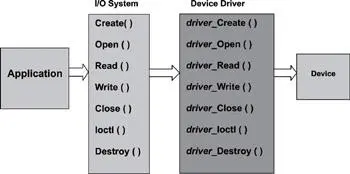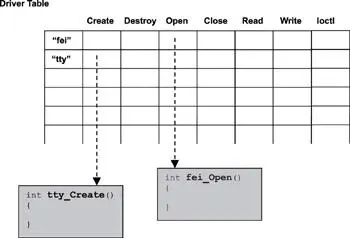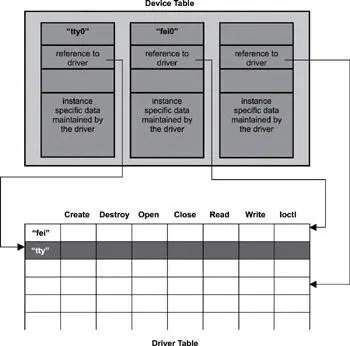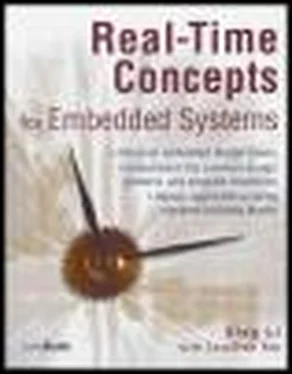The create function creates a virtual instance of an I/O device in the I/O subsystem, making the device available for subsequent operations, such as open, read, write, and ioctl. This function gives the driver an opportunity to prepare the device for use. Preparations might include mapping the device into the system memory space, allocating an available interrupt request line (IRQ) for the device, installing an ISR for the IRQ, and initializing the device into a known state. The driver allocates memory to store instance-specific information for subsequent operations. A reference to the newly created device instance is returned to the caller.
The destroy function deletes a virtual instance of an I/O device from the I/O subsystem. No more operations are allowed on the device after this function completes. This function gives the driver an opportunity to perform cleanup operations, such as un-mapping the device from the system memory space, de-allocating the IRQ, and removing the ISR from the system. The driver frees the memory that was used to store instance-specific information.
The open function prepares an I/O device for subsequent operations, such as read and write. The device might have been in a disabled state when the create function was called. Therefore, one of the operations that the open function might perform is enabling the device. Typically, the open operation can also specify modes of use; for example, a device might be opened for read-only operations or write-only operations or for receiving control commands. The reference to the newly opened I/O device is returned to the caller. In some implementations, the I/O subsystem might supply only one of the two functions, create and open, which implements most of the functionalities of both create and open due to functional overlaps between the two operations.
The close function informs a previously opened I/O device that its services are no longer required. This process typically initiates device-specific cleanup operations. For example, closing a device might cause it to go to a standby state in which it consumes little power. Commonly, the I/O subsystem supplies only one of the two functions, destroy and close, which implements most of the functionalities of both destroy and close, in the case where one function implements both the create and open operations.
The read function retrieves data from a previously opened I/O device. The caller specifies the amount of data to retrieve from the device and the location in memory where the data is to be stored. The caller is completely isolated from the device details and is not concerned with the I/O restrictions imposed by the device.
The write function transfers data from the application to a previously opened I/O device. The caller specifies the amount of data to transfer and the location in memory holding the data to be transferred. Again, the caller is isolated from the device I/O details.
The Ioctl function is used to manipulate the device and driver operating parameters at runtime.
An application is concerned with only two things in the context of uniform I/O: the device on which it wishes to perform I/O operations and the functions presented in this section. The I/O subsystem exports this API set for application use.
12.3.2 Mapping Generic Functions to Driver Functions
The individual device drivers provide the actual implementation of each function in the uniform I/O API set. Figure 12.6 gives an overview of the relationship between the I/O API set and driver internal function set.

Figure 12.6: I/O function mapping.
As illustrated in Figure 12.6, the I/O subsystem-defined API set needs to be mapped into a function set that is specific to the device driver for any driver that supports uniform I/O. The functions that begin with the driver _ prefix in Figure 12.6 refer to implementations that are specific to a device driver. The uniform I/O API set can be represented in the C programming language syntax as a structure of function pointers, as shown in the left-hand side of Listing 12.1.
Listing 12.1: C structure defining the uniform I/O API set.
typedef struct {
int (*Create)();
int (*Open) ();
int (*Read)();
int (*Write) ();
int (*Close) ();
int (*Ioctl) ();
int (*Destroy) ();
} UNIFORM_IO_DRV;
The mapping process involves initializing each function pointer with the address of an associated internal driver function, as shown in Listing 12.2. These internal driver functions can have any name as long as they are correctly mapped.
Listing 12.2: Mapping uniform I/O API to specific driver functions.
UNIFORM_IO_DRV ttyIOdrv;
ttyIOdrv.Create = tty_Create;
ttyIOdrv.Open = tty_Open;
ttyIOdrv.Read = tty_Read;
ttyIOdrv.Write = tty_Write;
ttyIOdrv.Close = tty_Close;
ttyIOdrv.Ioctl = tty_Ioctl;
ttyIOdrv.Destroy = tty_Destroy;
An I/O subsystem usually maintains a uniform I/O driver table . Any driver can be installed into or removed from this driver table by using the utility functions that the I/O subsystem provides. Figure 12.7 illustrates this concept.

Figure 12.7: Uniform I/O driver table.
Each row in the table represents a unique I/O driver that supports the defined API set. The first column of the table is a generic name used to associate the uniform I/O driver with a particular type of device. In Figure 12.7, a uniform I/O driver is provided for a serial line terminal device, tty. The table element at the second row and column contains a pointer to the internal driver function, tty_Create(). This pointer, in effect, constitutes an association between the generic create function and the driver-specific create function. The association is used later when creating virtual instances of a device.
These pointers are written to the table when a driver is installed in the I/O subsystem, typically by calling a utility function for driver installation. When this utility function is called, a reference to the newly created driver table entry is returned to the caller.
12.3.3 Associating Devices with Device Drivers
As discussed in the section on standard I/O functions, the create function is used to create a virtual instance of a device. The I/O subsystem tracks these virtual instances using the device table. A newly created virtual instance is given a unique name and is inserted into the device table, as shown in Figure 12.8. Figure 12.8 also illustrates the device table's relationship to the driver table.

Figure 12.8: Associating devices with drivers.
Each entry in the device table holds generic information, as well as instance-specific information. The generic part of the device entry can include the unique name of the device instance and a reference to the device driver. In Figure 12.8, a device instance name is constructed using the generic device name and the instance number. The device named tty0 implies that this I/O device is a serial terminal device and is the first instance created in the system. The driver-dependent part of the device entry is a block of memory allocated by the driver for each instance to hold instance-specific data. The driver initializes and maintains it. The content of this information is dependent on the driver implementation. The driver is the only entity that accesses and interprets this data.
Читать дальше















